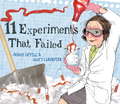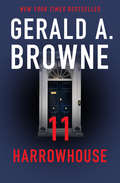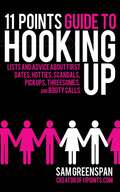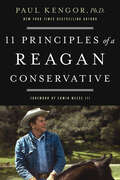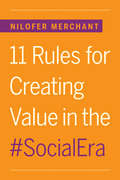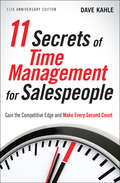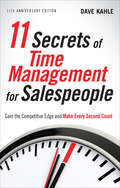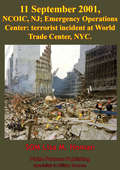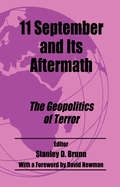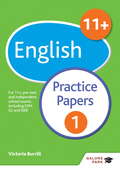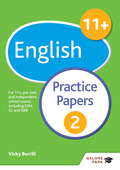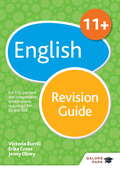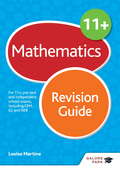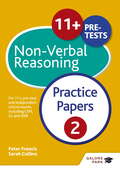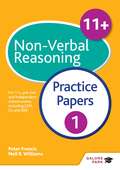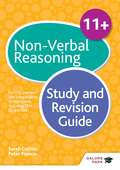- Table View
- List View
11 Experiments That Failed
by Jenny Offill Nancy Carpenter"This is a most joyful and clever whimsy, the kind that lightens the heart and puts a shine on the day," raved Kirkus Reviews in a starred review.Is it possible to eat snowballs doused in ketchup--and nothing else--all winter? Can a washing machine wash dishes? By reading the step-by-step instructions, kids can discover the answers to such all-important questions along with the book's curious narrator. Here are 12 "hypotheses," as well as lists of "what you need," "what to do," and "what happened" that are sure to make young readers laugh out loud as they learn how to conduct science experiments (really!). Jenny Offill and Nancy Carpenter--the ingenious pair that brought you 17 Things I'm Not Allowed to Do Anymore--have outdone themselves in this brilliant and outrageously funny book.From the Hardcover edition.
11 Harrowhouse
by Gerald A. BrowneThe classic New York Times–bestselling tale of suspense and intrigue that takes readers behind the scenes of the secretive billion-dollar diamond business From a centuries-old building on a narrow street in the heart of London, a firm known as the System, the world&’s most lucrative and least-known cartel, maintains a stranglehold on the world&’s diamonds. The company selects the stones a customer can buy and decides how much he must pay for the privilege. One dealer is tired of the game, and so he sets out to destroy the System forever. With the help of his mistress, Chesser sketches a plan to infiltrate the offices at 11 Harrowhouse—and make off with every diamond the System owns. But this billion-dollar heist is not as simple as it seems, for the System is always watching.
11 Out
by Michael GandyBased on a true story…eleven ophthalmology residents weigh leaving their program because their supervising physician is putting them in unethical, sometimes illegal, positions. But the medical school is taking his side.
11 Paper Hearts (Underlined Paperbacks)
by Kelsey HartwellPerfect for fans of To All the Boys I've Loved Before and The Kissing Booth, this teen romance is about a girl who follows a trail of paper hearts from her mystery admirer and learns that sometimes love can find you in mysterious ways. Ella&’s life was picture perfect. She had a circle of close friends, a jam-packed social life, and an amazing boyfriend. But then something completely unexpected happened: a car accident after a Valentine&’s Day dance. When Ella woke up in the hospital, she couldn&’t remember the accident . . . or anything about the weeks before it, including the reason she broke up with her boyfriend. Now, a year later, she begins receiving paper hearts from a mysterious admirer who seems to have the answers she craves. Ella is intrigued. The hearts contain clues to help Ella remember her life before . . . and take her on a journey she never imagined. Following the paper hearts is the most spontaneous thing Ella has ever done . . . but will she find love?Underlined is a line of totally addictive romance, thriller, and horror paperback original titles coming to you fast and furious each month. Enjoy everything you want to read the way you want to read it.
11 Points Guide to Hooking Up: Lists and Advice about First Dates, Hotties, Scandals, Pick-ups, Threesomes, and Booty Calls
by Sam GreenspanMost everyone has been, or will be, one half of a budding romantic relationship at least once-but not everyone knows how to successfully navigate those first-date butterflies, the potentially steamy bedroom scenes, and the ever-feared crushing moments of betrayal. 11 Points Guide to Hooking Up serves as a manual to dating, relationships, and sex-and is a wildly entertaining read for people who are single, taken, young, old, gay, straight, or anywhere in between. Creator Sam Greenspan blends his quirky humor, attuned sense of popular culture, and entertaining approach to produce thought-provoking lists about the ins and outs of dating. Prepare to take notes and laugh out loud with 11 Points Guide to Hooking Up.
11 Principles of a Reagan Conservative
by Paul KengorPerhaps no other president's name is invoked by politicians as much as Ronald Reagan's. Every election, as presidential hopefuls jockey for the Republican nomination, each one claims to be a Reagan conservative. But are these candidates truly carrying on the mantle of Ronald Reagan, or are they abusing the memory of our great president? What did Ronald Reagan really believe? In 11 Principles of a Reagan Conservative, biographer Paul Kengor analyzes Ronald Reagan's speeches and actions to paint a full, accurate picture of his beliefs. Kengor identifies these principles that lie at the crux of Reagan's conservatism; Freedom, Faith, Family, Sanctity and Dignity of Human Life, American Exceptionalism, The Founders' Wisdom and Vision, Lower Taxes, Limited Government, Peace Through Strength, Anti-Communism, and Belief in the Individual. And it is through these principles that Reagan's modern emulators may create a successful, conservative future.Many a politician has asked: What would Reagan do if he were president now? Where would Reagan stand on today's issues? Who is the next Ronald Reagan? Paul Kengor dissects Reagan's presidency and provides decisive conclusions. The answers to some of these questions may surprise conservatives and liberals alike.
11 Rules for Creating Value in the Social Era
by Nilofer MerchantThe era of social technologies provides seemingly endless opportunity, both for individuals and organizations. But it's also the subject of seemingly endless hype. Yes, social tools allow us to do things entirely differently-but how do you really capitalize on that?In 11 Rules for Creating Value in the Social Era, the newest in Harvard Business Review's line of digital books (HBR Singles), social strategist and insightful blogger Nilofer Merchant argues that "social" is much more than "media." Smart companies are letting social become the backbone of their business models, increasing their speed and flexibility by pursuing openness and fluidity. These organizations don't operate like the powerful "800-pound gorillas" of yesteryear-but instead act more like a herd of 800 gazelles, moving together across a savannah, outrunning the competition.This ebook offers new rules for creating value, leading, and innovating in our rapidly changing world. These social era rules are both provocative and grounded in reality-they cover thorny challenges like forsaking hierarchy and control for collaboration; getting the most out of all talent; allowing your customers to become co-creators in your organization; inspiring employees through purpose in a world where money alone no longer wields that power; and soliciting community investment in an idea so that it can take hold and grow.The strategies of the Industrial Era-or even the Information Age-will not be enough for the Social Era. Read 11 Rules for Creating Value in the Social Era to get ready to meet the challenges of this new age and thrive.HBR Singles provide brief yet potent business ideas, in digital form, for today's thinking professional.Editorial ReviewsNamed a "Best Business Book of 2012" by Fast Company"Ms. Merchant's new work provides a provocative vision of the future of both what organizations and what work might look like, yet grounded in real businesses today...this will inspire ideas and thought about what running a business really means." - Forbes.com"Every CEO, CMO, and decision maker needs to read this. Nilofer has taken a high-level concept and made it abundantly clear how to implement this big idea." - Tara Hunt, cofounder and CEO, Buyosphere; author, The Whuffie Factor: Using the Power of Social Networks to Build Your Business"A rare combination: strategic, well researched, and actionable. Nilofer Merchant helps executives see what's at stake in the connection economy." - Seth Godin, author, Meatball Sundae: Is Your Marketing Out of Sync?"Traditional strategy is dead. But do not fear-Nilofer Merchant shows how your organization can thrive with the new rules of the Social Era. Buy yourself a copy-and one for every member of your board." - Charlene Li, founder, Altimeter Group; author, Open Leadership: How Social Technology Can Transform the Way You Lead; and coauthor, Groundswell"Social media is not about hooking up online. It's becoming a new means of production and engagement. Nilofer lays out her enormously helpful '11 Rules' to embrace the Social Era." - Don Tapscott, coauthor, Macrowikinomics: Rebooting Business and the World"Pay attention to Nilofer Merchant. Or risk obsolescence." - Dave Gray, Senior Vice President, Dachis Group"Nilofer Merchant nails it in this important and timely book. It's an insightful road map. through the new world of business that embraces openness, stability, sustainable advantages, profitability, and the new value chain. It's all here for you to devour. I hope you're hungry." - Mitch Joel, President, Twist Image; author, Six Pixels of Separation: Everyone Is Connected. Connect Your Business to Everyone"Nilofer Merchant offers not just a name-the Social Era-to these confusing and turbulent times, but thoughtful and straightforward advice about how both institutions and people can thrive, not just be the last one standing. Required reading for today's leaders-and tomorrow's." - Barry Z. Posner, Accolti Professor of Leadership, Santa Clara University; coauthor, The Leadership Challenge: How to Make Extraordinary Things Happen in ...
11 Secrets of Time Management for Salespeople, 11th Anniversary Edition
by Dave KahleToday's typical salesperson is overwhelmed, with too much to do and not enough time to do it. Salespeople need help, and Dave Kahle provides it. Dave Kahle contends that smart time management is not about cramming more activity into each hour, but is instead about achieving greater results in that hour. The content has been honed in hundreds of seminars and refined by the feedback and experiences of thousands of salespeople. The first edition of this book was translated into seven languages and made available in twenty countries. Since then, the problem for salespeople has become even more acute, with smart phones and tablets creating a culture of instant communication. 11 Secrets of Time Management for Salespeople provides powerful, practical insights and ideas that really work, including hundreds of specific, practical, and effective time-management tips from dozens of salespeople who are on the front lines every day.
11 Secrets of Time Management for Salespeople: Gain the Competitive Edge and Make Every Second Count
by Dave KahleThe typical salesperson today is overwhelmed, with too much to do and not enough time in which to do it. Salespeople need help, and Dave Kahle provides it.Dave Kahle contends that smart time management is not about cramming more activity into each hour, but about achieving greater results in that hour. The content has been honed in hundreds of seminars and refined by the feedback and experiences of thousands of salespeople.The first edition of this book was translated into seven languages and made available in 20 countries. Since then, the problem for salespeople has become even more acute, with smart phones and tablets creating a culture of instant communication. Salespeople need assistance in not being seduced by all the digital noise.11 Secrets of Time Management for Salespeople provides powerful, practical insights and ideas that really work, including hundreds of specific, practical, effective time-management tips from dozens of salespeople who are on the front lines every day.
11 September 2001, NCOIC, NJ; Emergency Operations Center: Terrorist Incident At World Trade Center, NYC
by SGM Lisa M. HomanMy personal experience paper will be about my assignment as the New Jersey Army National Guard Emergency Operations (EOC) NCOIC at Fort Dix on 11 September 2001. I have many experiences in the field of state emergencies that range from floods to winter storms. This was my first terrorist event (although the U.S. has experienced home grown man-made disasters before).
11 September 2001: War, Terror and Judgement
by Bülent Gökay R.b.j.walkerIn a comprehensive study of the world since September 11th, 2001, the contributors to this volume offer a series of perspectives on current security trends. The scholars who participated in this study are from Europe, North America and Asia.
11 September and its Aftermath: The Geopolitics of Terror
by Stanley D. BrunnFirst published in 2004. Routledge is an imprint of Taylor & Francis, an informa company.
11+ English Practice Papers 1: For 11+, pre-test and independent school exams including CEM, GL and ISEB
by Victoria BurrillExam Board: ISEBLevel: 11 PlusSubject: EnglishFirst Teaching: September 2012First Exam: Autumn 2013Practice papers to test pupils ahead of pre-tests and 11 plus independent school entrance exams. Includes six model papers, each containing a comprehension and a writing paper that includes a total of 67 comprehension questions and 12 writing tasks. - Develops and perfects exam technique for all major pre-tests and 11 plus independent school exams including Consortium, CEM, GL and ISEB- Teaches pupils to improve their response rates with timed papers- A variety of exam paper styles to build exam-room confidence- Identifies weaker areas and improves results with detailed answers and commentary- Builds familiarity of the way short-format 11 plus tests are presentedThe brand new 11 plus and pre-test range has been constructed to help pupils follow a three step revision journey ..Step 1) 11 Plus English Revision GuideStep 2) Practice Papers11 Plus English Practice Papers 111 Plus English Practice Papers 2Step 3) WorkbooksSpelling and Vocabulary Workbook Age 8-10 Reading and Comprehension Workbook Age 9-11 Grammar and Punctuation Workbook Age 8-10 Writing Workbook Age 9-11
11+ English Practice Papers 2: For 11+, pre-test and independent school exams including CEM, GL and ISEB
by Andrew HammondFollowing on from Practice Papers 1, these papers further test pupils in preparation for the most challenging of pre-tests and 11+ independent school entrance exams. Includes six model papers, each containing a comprehension and a writing paper that include a total of 104 comprehension questions, 31 spelling, grammar and punctuation questions and 15 writing tasks. - Develops and perfects exam technique for all major pre-tests and 11+ independent school exams including Consortium, CEM, GL and ISEB- Teaches pupils to improve their response rates with timed papers- A variety of exam paper styles to build exam-room confidence- Identifies weaker areas and improves results with detailed answers and commentary- Builds familiarity of the way long-format 11+ tests are presented- Tackles comprehension questions to make pupils think closely about the textThe brand new 11+ and pre-test range has been constructed to help pupils follow a three step revision journey ..Step 1) 11+ English Revision GuideStep 2) Practice Papers11+ English Practice Papers 111+ English Practice Papers 2Step 3) WorkbooksSpelling and Vocabulary Workbook Age 8-10 Reading and Comprehension Workbook Age 9-11 Grammar and Punctuation Workbook Age 8-10 Writing Workbook Age 9-11
11+ English Practice Papers 2: For 11+, pre-test and independent school exams including CEM, GL and ISEB
by Victoria BurrillExam Board: ISEBLevel: 11 PlusSubject: EnglishFirst Teaching: September 2012First Exam: Autumn 2013Following on from Practice Papers 1, these papers further test pupils in preparation for the most challenging of pre-tests and 11 plus independent school entrance exams. Includes six model papers, each containing a comprehension and a writing paper that include a total of 104 comprehension questions, 31 spelling, grammar and punctuation questions and 15 writing tasks. - Develops and perfects exam technique for all major pre-tests and 11 plus independent school exams including Consortium, CEM, GL and ISEB- Teaches pupils to improve their response rates with timed papers- A variety of exam paper styles to build exam-room confidence- Identifies weaker areas and improves results with detailed answers and commentary- Builds familiarity of the way long-format 11 plus tests are presented- Tackles comprehension questions to make pupils think closely about the textThe brand new 11 plus and pre-test range has been constructed to help pupils follow a three step revision journey ..Step 1) 11 Plus English Revision GuideStep 2) Practice Papers11 Plus English Practice Papers 111 Plus English Practice Papers 2Step 3) WorkbooksSpelling and Vocabulary Workbook Age 8-10 Reading and Comprehension Workbook Age 9-11 Grammar and Punctuation Workbook Age 8-10 Writing Workbook Age 9-11
11+ English Practice Papers: For 11+, pre-test and independent school exams including CEM, GL and ISEB
by Victoria BurrillPractice papers to test pupils ahead of pre-tests and 11+ independent school entrance exams. Includes six model papers, each containing a comprehension and a writing paper that includes a total of 67 comprehension questions and 12 writing tasks. - Develops and perfects exam technique for all major pre-tests and 11+ independent school exams including Consortium, CEM, GL and ISEB- Teaches pupils to improve their response rates with timed papers- A variety of exam paper styles to build exam-room confidence- Identifies weaker areas and improves results with detailed answers and commentary- Builds familiarity of the way short-format 11+ tests are presentedThe brand new 11+ and pre-test range has been constructed to help pupils follow a three step revision journey ..Step 1) 11+ English Revision GuideStep 2) Practice Papers11+ English Practice Papers 111+ English Practice Papers 2Step 3) WorkbooksSpelling and Vocabulary Workbook Age 8-10 Reading and Comprehension Workbook Age 9-11 Grammar and Punctuation Workbook Age 8-10 Writing Workbook Age 9-11
11+ English Revision Guide 2nd Edition: For 11+, pre-test and independent school exams including CEM, GL and ISEB
by Victoria Burrill Jenny Olney Erika CrossSecure the top marks in 11+ independent school entrance exams and pre-tests and a better chance at getting into their school of choice with this essential revision guide. Complete coverage of the ISEB 11+ English syllabus and stretching extra content ensures that every topic is thoroughly revised ahead of the exams.- This book covers everything required for the 11+ English exam- Prepares pupils for a wide range of independent school exams and pre-tests with challenging extension material- Consolidates revision with all the key information in one place- Features helpful insight in to the exams, with examples, practical tips and advice- Tests understanding and technique with timed, levelled exam-style questions- Identifies strengths and weaknesses using 11+ sample tests with detailed answer guidanceAlso available for 11+ English preparation: - Spelling & Vocabulary Workbook 9-11 9781471829642- Reading & Comprehension Workbook 9-11 9781471829659- Grammar & Punctuation Workbook 9-11 9781471829666- Writing Workbook 9-11 9781471829673- 11+ English Practice Papers ISBN 9781471849275Revision Guides, Workbooks and Practice Papers are also available for Maths, Science, Verbal Reasoning and Non-Verbal Reasoning on www.galorepark.co.uk.
11+ English Revision Guide: For 11+, pre-test and independent school exams including CEM, GL and ISEB
by Victoria Burrill Jenny Olney Erika CrossExam Board: ISEBLevel: 11 PlusSubject: EnglishFirst Teaching: September 2012First Exam: Autumn 2013Secure the top marks in 11 plus independent school entrance exams and pre-tests and a better chance at getting into their school of choice with this essential revision guide. Complete coverage of the ISEB 11 Plus English syllabus and stretching extra content ensures that every topic is thoroughly revised ahead of the exams.- This book covers everything required for the 11 Plus English exam- Prepares pupils for a wide range of independent school exams and pre-tests with challenging extension material- Consolidates revision with all the key information in one place- Features helpful insight in to the exams, with examples, practical tips and advice- Tests understanding and technique with timed, levelled exam-style questions- Identifies strengths and weaknesses using 11 plus sample tests with detailed answer guidanceAlso available for 11 Plus English preparation: - Spelling & Vocabulary Workbook 9-11 9781471829642- Reading & Comprehension Workbook 9-11 9781471829659- Grammar & Punctuation Workbook 9-11 9781471829666- Writing Workbook 9-11 9781471829673- 11 Plus English Practice Papers ISBN 9781471849275Revision Guides, Workbooks and Practice Papers are also available for Maths, Science, Verbal Reasoning and Non-Verbal Reasoning on www.galorepark.co.uk.
11+ Maths Revision Guide: For 11+, pre-test and independent school exams including CEM, GL and ISEB
by Louise MartineExam Board: ISEBLevel: 11 PlusSubject: MathsFirst Teaching: September 2015First Exam: Autumn 2016Secure the top marks in 11 plus independent school entrance exams and Pre-Tests leading to a better chance at getting into the school of choice with this essential revision guide. Complete coverage of the ISEB 11 Plus Maths syllabus and stretching extra content ensures that every topic is thoroughly revised ahead of the exams.This book covers everything required for the 11 Plus Maths exam- Prepares pupils for a wide range of independent school exams and pre-tests with challenging extension material- Consolidates revision with all the key information in one place- Features helpful insight in to the exams, with examples, practical tips and advice- Tests understanding and technique with timed, levelled exam-style questionsAlso available for 11 Plus Maths preparation: - 10-Minute Maths Tests Workbook Age 8-10 9781471829611- 10-Minute Maths Tests Workbook Age 9-11 9781471829635- Mental Arithmetic Workbook Age 8-10 9781471829505- Mental Arithmetic Workbook Age 9-11 9781471829628Revision Guides, Workbooks and Practice Papers are also available for English, Science, Verbal Reasoning and Non-Verbal Reasoning on www.galorepark.co.uk
11+ Non-Verbal Reasoning Practice Papers 2: For 11+, pre-test and independent school exams including CEM, GL and ISEB
by Peter Francis Sarah CollinsPrepare for the most challenging of pre-tests and 11+ independent school entrance exams with six levelled exam papers designed to test pupils' skills in Non-Verbal Reasoning exams for a better chance at getting into their school of choice. - Develops and perfects exam technique for all major pre-test and 11+ independent school exams including CEM, GL and ISEB- Features levelled papers to help build skills for the top marks - Teaches pupils to improve their response rates with timed papers- Builds exam-room confidence by practising with a variety of exam paper styles- Identifies weaker areas and improves results with detailed answers and commentaryAlso available for 11+ Non-Verbal Reasoning preparation: · 11+ Non-Verbal Reasoning Revision Guide ISBN xxx· Non-Verbal Reasoning Workbook Age 8-10 ISBN xxx· Non-Verbal Reasoning Workbook Age 9-11 ISBN xxx· Non-Verbal Reasoning Workbook Age 10-12 ISBN xx Revision Guides, Workbooks and Practice Papers are also available for Maths, English, Science and Verbal Reasoning on www.galorepark.co.uk.
11+ Non-Verbal Reasoning Practice Papers 1: For 11+, pre-test and independent school exams including CEM, GL and ISEB
by Peter Francis Sarah Collins Neil R WilliamsExam Board: ISEBLevel: 11 PlusSubject: Non-Verbal ReasoningFirst Teaching: September 2016First Exam: Spring 2017Practice exam papers to prepare children for the most challenging of pre-tests and 11 plus independent school entrance exams. Includes 9 levelled exam papers that will test pupils' skills in Non-Verbal Reasoning.- Develops exam techniques tested in all major pre-tests and 11 plus independent school examinations including CEM, GL and ISEB- Features papers written to measured levels of difficulty to help build skills- Teaches pupils to improve their response rates with timed papers- Builds exam-room confidence by practicing with a variety of exam paper styles- Identifies weaker areas and improves results with detailed answers and commentaryAlso available for 11 Plus Non-Verbal Reasoning preparation: - 11 Plus Non-Verbal Reasoning Revision Guide- Non-Verbal Reasoning Workbook Age 8-10- Non-Verbal Reasoning Workbook Age 9-11- Non-Verbal Reasoning Workbook Age 10-12
11+ Non-Verbal Reasoning Practice Papers 2: For 11+, pre-test and independent school exams including CEM, GL and ISEB
by Peter Francis Sarah CollinsPrepare for the most challenging of pre-tests and 11+ independent school entrance exams with six levelled exam papers designed to test pupils' skills in Non-Verbal Reasoning exams for a better chance at getting into their school of choice. - Develops and perfects exam technique for all major pre-test and 11+ independent school exams including CEM, GL and ISEB- Features levelled papers to help build skills for the top marks - Teaches pupils to improve their response rates with timed papers- Builds exam-room confidence by practising with a variety of exam paper styles- Identifies weaker areas and improves results with detailed answers and commentaryAlso available for 11+ Non-Verbal Reasoning preparation: · 11+ Non-Verbal Reasoning Revision Guide ISBN xxx· Non-Verbal Reasoning Workbook Age 8-10 ISBN xxx· Non-Verbal Reasoning Workbook Age 9-11 ISBN xxx· Non-Verbal Reasoning Workbook Age 10-12 ISBN xx Revision Guides, Workbooks and Practice Papers are also available for Maths, English, Science and Verbal Reasoning on www.galorepark.co.uk.
11+ Non-Verbal Reasoning Practice Papers: For 11+, pre-test and independent school exams including CEM, GL and ISEB
by Peter Francis Sarah Collins Neil R WilliamsPractice exam papers to prepare children for the most challenging of pre-tests and 11+ independent school entrance exams. Includes 9 levelled exam papers that will test pupils' skills in Non-Verbal Reasoning- Develops exam techniques tested in all major pre-tests and 11+ independent school examinations including CEM, GL and ISEB- Features papers written to measured levels of difficulty to help build skills- Teaches pupils to improve their response rates with timed papers- Builds exam-room confidence by practicing with a variety of exam paper styles- Identifies weaker areas and improves results with detailed answers and commentaryAlso available for 11+ Non-Verbal Reasoning preparation: - 11+ Non-Verbal Reasoning Revision Guide- Non-Verbal Reasoning Workbook Age 8-10- Non-Verbal Reasoning Workbook Age 9-11- Non-Verbal Reasoning Workbook Age 10-12Revision Guides, Workbooks and Practice Papers are also available for Maths, English, Science and Verbal Reasoning on www.galorepark.co.uk.
11+ Non-Verbal Reasoning Study and Revision Guide: For 11+, pre-test and independent school exams including CEM, GL and ISEB
by Peter Francis Sarah CollinsSecure the top marks in 11+ independent school entrance exams and pre-tests and a better chance at getting into their school of choice with this essential study and revision guide. Stretching content ensures that all the Non-Verbal Reasoning skills are thoroughly revised ahead of the exams.- Explains and tests the full range of question types and skills met in Non-Verbal Reasoning in exams- Prepares pupils for a wide range of independent school exams and pre-tests with challenging extension material- Builds on existing knowledge with clear cross-curricular links to English- Features helpful insight in to the exams, with examples, practical tips and advice- Prepares pupils for exam conditions with timed and levelled exam-style questions- Identifies strengths and weaknesses using 11+ sample tests with detailed answer guidanceAlso available for 11+ Verbal Reasoning preparation: - Non-Verbal Reasoning Workbook Age 8-10 - Non-Verbal Reasoning Workbook Age 9-11 - Non Verbal Reasoning Workbook Age 10-12 - 11+ Non- Verbal Reasoning Practice Papers 1&2Revision Guides, Workbooks and Practice Papers are also available for Maths, English, Science and Verbal Reasoning on www.galorepark.co.uk
11+ Non-Verbal Reasoning Study and Revision Guide: For 11+, pre-test and independent school exams including CEM, GL and ISEB
by Peter Francis Sarah CollinsExam Board: ISEBLevel: 11 PlusSubject: Non-Verbal ReasoningFirst Teaching: September 2016First Exam: Spring 2017Secure the top marks in 11 plus independent school entrance exams and pre-tests and a better chance at getting into their school of choice with this essential study and revision guide. Stretching content ensures that all the Non-Verbal Reasoning skills are thoroughly revised ahead of the exams.- Explains and tests the full range of question types and skills met in Non-Verbal Reasoning in exams- Prepares pupils for a wide range of independent school exams and pre-tests with challenging extension material- Builds on existing knowledge with clear cross-curricular links to English- Features helpful insight in to the exams, with examples, practical tips and advice- Prepares pupils for exam conditions with timed and levelled exam-style questions- Identifies strengths and weaknesses using 11 plus sample tests with detailed answer guidanceAlso available for 11 Plus Verbal Reasoning preparation: - Non-Verbal Reasoning Workbook Age 8-10 - Non-Verbal Reasoning Workbook Age 9-11 - Non Verbal Reasoning Workbook Age 10-12 - 11+ Non- Verbal Reasoning Practice Papers 1&2Revision Guides, Workbooks and Practice Papers are also available for Maths, English, Science and Verbal Reasoning on www.galorepark.co.uk
